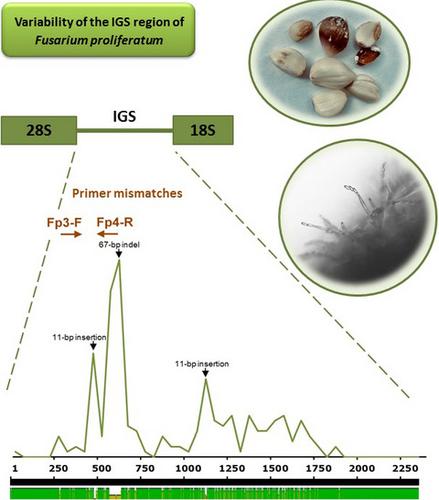当前位置:
X-MOL 学术
›
Plant Pathol.
›
论文详情
Our official English website, www.x-mol.net, welcomes your feedback! (Note: you will need to create a separate account there.)
IGS region polymorphisms are responsible for failure of commonly used species‐specific primers in Fusarium proliferatum isolates from diseased garlic
Plant Pathology ( IF 2.7 ) Pub Date : 2020-05-01 , DOI: 10.1111/ppa.13162 Laura Gálvez 1 , John P. Clarkson 2 , Daniel Palmero 1
Plant Pathology ( IF 2.7 ) Pub Date : 2020-05-01 , DOI: 10.1111/ppa.13162 Laura Gálvez 1 , John P. Clarkson 2 , Daniel Palmero 1
Affiliation

|
Fusarium proliferatum is a globally distributed fungal pathogen that affects a range of crop hosts and is one of the main producers of mycotoxins, such as fumonisins, in foods. Specific PCR primers are commonly used for detection and identification of this pathogen. The aim of this study was to validate previously published F. proliferatum‐specific primers targeting the intergenic spacer (IGS) region and characterize intraspecific variation and homologous recombination events for isolates obtained from diseased garlic bulbs in Spain. Sixty‐nine isolates were morphologically identified as F. proliferatum, and their identity was confirmed by sequencing of the translation elongation factor; however, specific IGS primers did not result in an amplification product for nine of these isolates. Further analysis showed that this was due to polymorphism in the IGS region and six isolates were classified as IGS type I, while the remaining isolates were type II. Sequencing of the complete IGS region revealed numerous sequence polymorphisms amongst F. proliferatum isolates, and regions of recombination. Duplication and deletion events may have occurred via unequal crossing over during mitotic or meiotic recombination. These results suggest that the IGS region may be too variable as a reliable target for F. proliferatum‐specific identification.
中文翻译:

IGS 区域多态性是导致从患病大蒜中分离出的增殖镰刀菌中常用物种特异性引物失败的原因
Fusarium proliferatum 是一种全球分布的真菌病原体,会影响一系列作物宿主,并且是食物中真菌毒素(如伏马菌素)的主要生产者之一。特异性 PCR 引物通常用于检测和鉴定这种病原体。本研究的目的是验证先前发表的 F. proliferatum 特异性引物,靶向基因间间隔 (IGS) 区域,并表征从西班牙患病大蒜鳞茎中获得的分离株的种内变异和同源重组事件。69株分离株在形态学上被鉴定为F. proliferatum,并通过翻译延伸因子测序证实其身份;然而,特异的 IGS 引物并没有导致其中 9 个分离株的扩增产物。进一步分析表明,这是由于 IGS 区域的多态性所致,6 个分离株被归类为 IGS I 型,其余分离株为 II 型。完整 IGS 区域的测序揭示了增殖 F. proliferatum 分离株和重组区域之间的众多序列多态性。在有丝分裂或减数分裂重组过程中,通过不等交换可能发生复制和缺失事件。这些结果表明,作为 F. proliferatum 特异性鉴定的可靠目标,IGS 区域可能变化太大。在有丝分裂或减数分裂重组过程中,通过不等交换可能发生复制和缺失事件。这些结果表明,作为 F. proliferatum 特异性鉴定的可靠目标,IGS 区域可能变化太大。在有丝分裂或减数分裂重组过程中,通过不等交换可能发生复制和缺失事件。这些结果表明,作为 F. proliferatum 特异性鉴定的可靠目标,IGS 区域可能变化太大。
更新日期:2020-05-01
中文翻译:

IGS 区域多态性是导致从患病大蒜中分离出的增殖镰刀菌中常用物种特异性引物失败的原因
Fusarium proliferatum 是一种全球分布的真菌病原体,会影响一系列作物宿主,并且是食物中真菌毒素(如伏马菌素)的主要生产者之一。特异性 PCR 引物通常用于检测和鉴定这种病原体。本研究的目的是验证先前发表的 F. proliferatum 特异性引物,靶向基因间间隔 (IGS) 区域,并表征从西班牙患病大蒜鳞茎中获得的分离株的种内变异和同源重组事件。69株分离株在形态学上被鉴定为F. proliferatum,并通过翻译延伸因子测序证实其身份;然而,特异的 IGS 引物并没有导致其中 9 个分离株的扩增产物。进一步分析表明,这是由于 IGS 区域的多态性所致,6 个分离株被归类为 IGS I 型,其余分离株为 II 型。完整 IGS 区域的测序揭示了增殖 F. proliferatum 分离株和重组区域之间的众多序列多态性。在有丝分裂或减数分裂重组过程中,通过不等交换可能发生复制和缺失事件。这些结果表明,作为 F. proliferatum 特异性鉴定的可靠目标,IGS 区域可能变化太大。在有丝分裂或减数分裂重组过程中,通过不等交换可能发生复制和缺失事件。这些结果表明,作为 F. proliferatum 特异性鉴定的可靠目标,IGS 区域可能变化太大。在有丝分裂或减数分裂重组过程中,通过不等交换可能发生复制和缺失事件。这些结果表明,作为 F. proliferatum 特异性鉴定的可靠目标,IGS 区域可能变化太大。


























 京公网安备 11010802027423号
京公网安备 11010802027423号